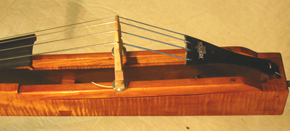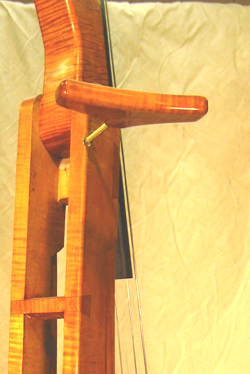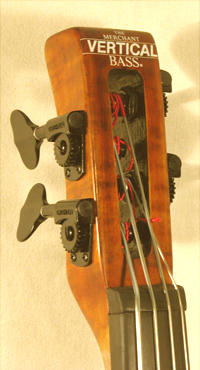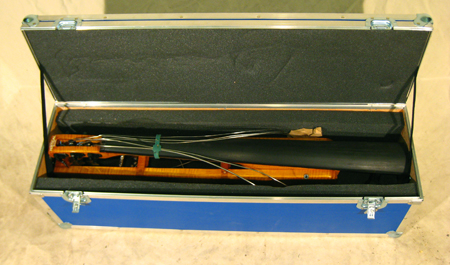![]()
  |
|
The electric upright made by a double bass luthier to sound and feel like an acoustic bass has just gotten more portable. My new MVB-2 bass folds in less than a minute and fits in a small (42.5" x 13" x 12.5") case weighing only 35 pounds (including the bass) for easier travel. It can be reset to the exact set up in less than a minute, too.
|
|
|
The
Merchant Vertical Bass has been featured by such artists as Eddie Gomez,
Harvie S, Terou Nakamura, Hall & Oates, Suzanne Vega, Steve Bailey,
Ratzo B. Harris, Spyro Gyra, Kitaro, US Air Force bands and many others.
|
| The Merchant Vertical Bass uses Spruce Spring Bars (U.S. Patent #4,635,523) to give the bridge the flexibility it would have on the top of an acoustic bass. The bars allow me to make the string tension identical to an acoustic to give the same sound and feel on the electric instrument. |  |
|
The main function of a bass violin’s top is to act as a speaker cone,
producing an amplified sound wave at the frequency of the strings’ vibration.
To do this the top is quite flexible, allowing the bridge (and therefore
the strings) to move, encouraging that vibration. One of the features
that sets the Vertical Bass apart from others is the patented Spruce Spring
Bars, which allows the bridge to move much like it would on the top of
a bass violin.
I use the Fishman Full Circle transducer system to provide a remarkably accurate rendition of the sound of the double bass. I can also make it with transducers from B-Band, Barbera and others, as a custom order. |
|
The solid flamed maple neck pivots on the matching body and has a fingerboard of select ebony. I bolt the necks under the fingerboard at the neck butt end to eliminate the possibility of the wood splitting along the grain at the pivot. The bass can be folded in half (and re-deployed) in less than a minute. I finish my basses with a centuries old violin varnish like the craftsman of old then over coat it with an environmentally friendly water based lacquer that I hand rub to a warm luster.
|
 |
An adjustable solid wood side brace screws into the player’s side of the bass to give the feel of an acoustic bass and to put the strings where the player is used to finding them. The bass has a removable end pin with a "T" bar added to the bottom to stabilize it. The side, endpin and bridge are all that is removed when folding the bass. The headstock of my bass is smaller, lighter and stronger than a traditional double bass scroll and pegbox. This design prevents "scroll snapoff" - splitting along the grain on the side of the pegbox. As a result the instrument is lighter and has better balance. |
 |

|
The Merchant Vertical
Bass comes with a padded gig bag that features an adjustable shoulder
strap with a neck cinch, a pair of centered handles and a neck handle
for easy loading. There is a large pocket for the side bout with extra
room for cables, tuner etc.The case folds and can be used when the
bass is collapsed as well as when strung up. It all fits inside the
ATA flight case. A custom polyethlene case is available for $400.
additional. |
|
The tuning gears are high quality- made in America by Grover. Black finish is stock but chrome & gold are also available. The bass can also be made with five strings. I also make the Ratzo Harris signature six string, with a low B and high C strings. |
|
The
string length of a double bass can vary from about 38" to 44".
The note at the neck butt is generally either "D" or "E
flat". If you have an upright bass I can make your Vertical
Bass to match its' string length and "neck note" by having
you take two simple measurements (see Order
page). The shape of the neck and fingerboard curve can be custom
shaped as well. If this is your only upright I suggest 41 1/2"
with an E flat neck. The Merchant Vertical Bass is the only electric
upright that is made to match
the individual players' instrument, making it easier to play in
tune when switching between the two.
You can see how I shape necks in the Scroll Graft feature in the acoustic section of my site.
|
Any questions? E-mail me-bill@merchantbass.com
Copyright 2009 William E. Merchant, all rights reserved